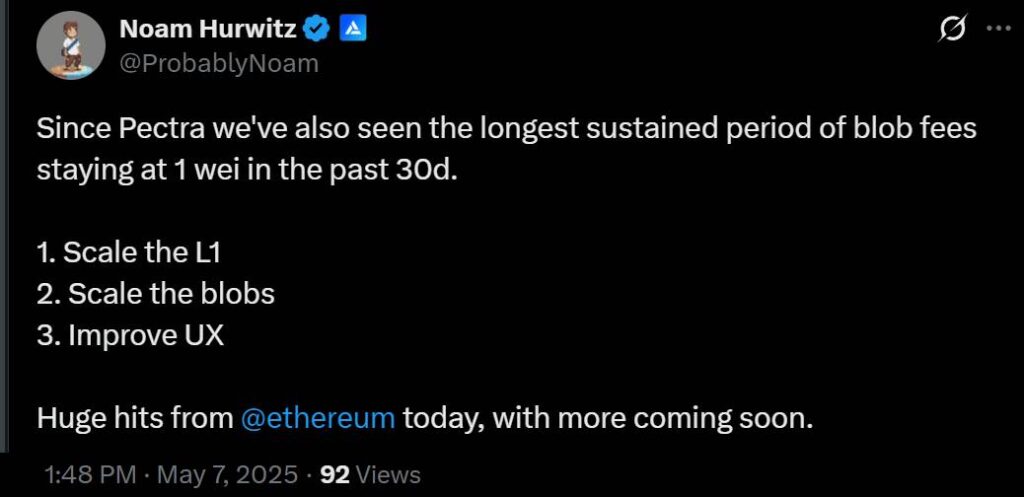Ethereum (ETH) has found itself at a pivotal moment as it attempts to regain the crucial price point of $2,200. Despite a recent network upgrade known as the Pectra update on May 7, the market’s reaction has been tepid. Analysts are scratching their heads, questioning whether Ethereum can truly rally 22% from its current price around $1,810.
The subdued performance of ETH is underscored by the ongoing lack of enthusiasm among traders, as highlighted by its futures premium remaining stagnant below the neutral threshold. This hesitancy seems to echo a broader investor sentiment, as macroeconomic uncertainties loom and concerns about global trade disputes mount. Notably, Ethereum has struggled to keep pace with the overall cryptocurrency market, underperforming by a significant 28% during the first quarter of 2025.
The Pectra upgrade, while a meaningful step forward, hasn’t significantly boosted Ethereum’s competitiveness, especially against rival blockchains like Solana and BNB Chain.
Declining activity on the Ethereum network is concerning, particularly as Solana thrives with a staggering 82.2 million monthly active addresses compared to Ethereum’s leading layer-2 solution, Base, which has only 10.3 million. Moreover, Ethereum’s high transaction fees, historically a barrier to network activity, have dropped below $1, yet the benefits of this decline haven’t translated into a robust uptick in user engagement.
While Ethereum remains the leader in total value locked (TVL) with $53.7 billion, low network fees suggest that this dominance is not translating into significant advantage for current ETH holders. In contrast, competitors like Tron and Solana have demonstrated stronger fee accruals, further illustrating Ethereum’s challenges in attracting active users.
As Ethereum navigates these hurdles, experts stress that improvements in scalability and user experience are paramount for rejuvenating interest in DApps and stabilizing ETH’s market position.
The road ahead for Ether relies heavily on demonstrating tangible benefits from its network upgrades, whether through enhanced staking yields or enticing user incentives that could spur greater engagement with decentralized applications. Stakeholders are eagerly watching to see if Ethereum can harness its technological advancements to transform market sentiment and ultimately achieve the price recovery it desperately seeks.
Key Takeaways on Ethereum’s Market Outlook
The following points outline the current challenges and potential future of Ethereum (ETH) and its impact on investors and users in the cryptocurrency space:
- Price Challenge:
The first significant hurdle for ETH is reclaiming the $2,200 level, which raises questions about its price stability and growth potential.
- Impact of Pectra Upgrade:
The recent Pectra upgrade, implemented on May 7, was expected to boost DApp and network activity but has shown a lackluster response, leading to skepticism among traders.
- Low Futures Premium:
ETH futures premium remains below the neutral threshold of 5%, indicating a lack of enthusiasm from leveraged investors. The premium stayed unchanged at 3% after the upgrade.
- Macroeconomic Concerns:
Investors are currently more focused on macroeconomic issues, such as recession risks and global trade disputes, which have created a challenging environment for ETH.
- Network Activity:
Despite Ethereum’s leading position in total value locked (TVL) at $53.7 billion, its low network fees ($19 million) indicate minimal benefits for ETH holders compared to its competitors.
- Layer-2 and DApp Competition:
Ethereum’s leading layer-2 solution, Base, has significantly fewer monthly active users compared to Solana and BNB Chain, raising concerns about its usability and appeal.
- Interoperability Challenges:
Bridging assets and data across Ethereum’s layer-2 ecosystem remains difficult, limiting user engagement and potentially hindering continued growth in DApp usage.
- Future Growth Needs:
For ETH to see a price increase of 22% from its current level, investors will seek clearer benefits from network developments, including better staking yields and stronger incentives for DApp usage.
This information highlights the various factors influencing Ethereum’s market position and potential growth, providing insights for readers interested in the future of cryptocurrency investments.
ETH Faces Challenges in the Competitive Crypto Landscape
The recent developments surrounding Ethereum (ETH) and its Pectra upgrade have important implications in the world of cryptocurrencies. While it has historically been a leader, Ethereum now finds itself competing with rising contenders like Solana and Tron, which have started to capture market share in ways that pose challenges for ETH.
Competitive Advantages: Ethereum retains its status as the top blockchain by total value locked (TVL), boasting an impressive $53.7 billion. This leads to a sense of trust and stability among developers and investors, particularly for decentralized applications (DApps). Furthermore, the successful implementation of network upgrades can be seen as a commitment to continual improvement, hinting at a long-term vision that can attract serious investors when market conditions stabilize.
Disadvantages: Despite these positives, Ethereum’s market performance has fallen short, notably due to a lack of significant price movement following the Pectra upgrade. This has raised alarms about its long-term viability, especially as it struggles with high fees and interoperability issues compared to other blockchains. Solana and BNB Chain, for instance, have experienced smoother DApp user experiences and lower operating costs, yielding higher user engagement. The stagnation in Ethereum’s futures premium—remaining below the neutral threshold—indicates waning interest from leveraged traders, which could point towards deeper market skepticism.
Impact on Investors and Users: Ethereum’s current predicament, particularly the inability to reclaim the crucial $2,200 price point, could deter new investors who are attracted to the lucrative offerings of competing platforms. Ethereum enthusiasts may find themselves at risk if the network cannot effectively address interoperability challenges or enhance the user experience. For developers, the ongoing issues could slow down the deployment of new DApps, hindering innovation within the Ethereum ecosystem. In contrast, platforms like Solana and Tron may benefit from Ethereum’s troubles, potentially attracting talent and investments away from the Ethereum network.
Ultimately, Ether’s path going forward will be determined by its ability to adapt and innovate in a fiercely competitive market. Stakeholders will be watching closely to see if the anticipated improvements can lead to greater user engagement and a rebound in demand for ETH.

















